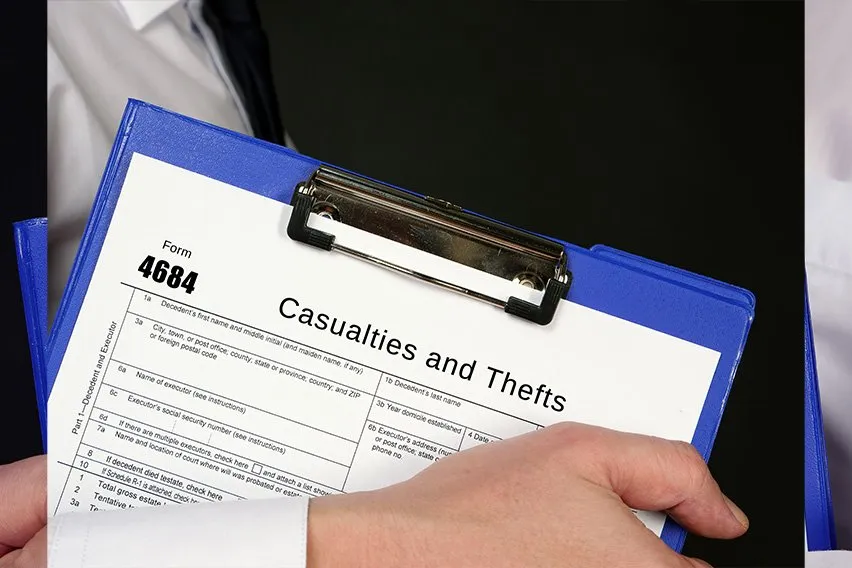Can You Write-off Theft on Taxes? Not Anymore.

You can no longer claim theft losses on a tax return unless the loss is attributable to a federally declared disaster. This deduction has been suspended until at least 2026 under the new Tax Cuts and Jobs Act (TCJA) that went into effect under President Trump’s administration on January 1, 2018. This suspension applies to both individuals and businesses.
Here’s What We’ll Cover
What Is the Tax Form to Declare Theft?
What Is an Example of a Theft Loss Deduction?
What Is a Theft or Casualty Gain?

What Is a Theft Loss?
A Theft Loss is when an owner has been deprived of money or property deliberately. These crimes include:
- Burglary
- Blackmail
- Embezzlement
- Extortion
- Kidnapping
- Robbery
- Fraud
- Larceny
In order to be considered ‘theft loss”, there has to be no expectation of the money’s return.
If a taxpayer simply ‘lost’ the money, or loaned it to a family member or friend who did not pay back the funds, then these situations do not qualify. However, if the claimant ordered something off the internet, and did not receive the item or a refund, or if money was stolen directly from his bank account, then all of these situations qualify. In addition to what has been listed above, they would be considered ‘theft loss’. Pre-2018 tax reform, a taxpayer would have been able to write them off.
The law has changed under the Trump administration, which in late 2017 passed into law the Tax Cuts and Jobs Act (TCJA). Since January 1, 2018, no longer can a taxpayer deduct theft on his taxes, unless it was due to a federally declared disaster.
It should be noted that these changes are not permanent, TCJA will only be in effect until the end of 2025. Unless further changes are made before that time, the law will again allow for tax write-offs from theft starting January 1, 2026.
What Is a Casualty Loss?
Casualty losses refer to losses other than thefts, typically they are considered disasters. It occurs when an owner has been partially or fully deprived of property from fire, flood, hurricane, tornado or a volcano. Vandalism, car accidents and shipwrecks from a sudden or unexpected event can also be considered casualty losses.
A taxpayer must own or lease the property to make a casualty loss claim. Normal wear and tear on a property due to its age, or termite damage, does not qualify.
As with theft loss, these deductions have been suspended with the new Tax Cuts and Jobs Act. There is an exception. If the area where the loss happened is declared a federal disaster, then casualty loss deductions are still allowable. For instance, President Trump declared parts of Florida a major disaster area in October of 2018 due to the damage caused by Hurricane Michael. For people living in the declared areas, they were able to make the casualty loss deductions in 2019 when they filed their taxes for 2018.
What Is the Tax Form to Declare Theft?
Form 4684 is the appropriate document. A PDF of the 2023 form, for reference, can be accessed here from the IRS’s site.

What Is an Example of a Theft Loss Deduction?
Here is an example of a theft loss deduction. David gives his fiancé June a cheque for $100,000 so he can partner in her business. The terms of the financial agreement require June to pay David back on a staggered payment schedule. June later disappears with his investment, and two years later when she is finally apprehended and arrested, a search discovers June has spent $50,000 of his money.
June is convicted of fraud, and David is able to get the remaining money back. Previously, before the Tax Cuts and Jobs Act passed, David would have been able to claim a deduction on the lost $50,000 come tax time. Although presently he can no longer do that, the law will allow for these types of deductions again come 2026.
What Is a Theft or Casualty Gain?
This is a situation in which a taxpayer actually has a taxable gain after a situation involving theft or casualty loss. This is most likely due to an insurance payment. As such, a taxpayer may need to pay income tax on the gain, depending on the situation.
The gain is not the full amount, just the difference between the value of the property (at the time of loss), and the amount paid out.
RELATED ARTICLES

 Tax Deductions for Hobby Business: How Much Can I Deduct?
Tax Deductions for Hobby Business: How Much Can I Deduct? Travel Expense Deductions 101
Travel Expense Deductions 101 Miscellaneous Expenses: Definition, Deductible Expenses and Examples
Miscellaneous Expenses: Definition, Deductible Expenses and Examples Tax Deductions for Home Office: A Guide for Small Businesses
Tax Deductions for Home Office: A Guide for Small Businesses Is Interest on Mortgage Tax Deductible? a Primer.
Is Interest on Mortgage Tax Deductible? a Primer. 7 Best Business Expense Tracker of 2025
7 Best Business Expense Tracker of 2025